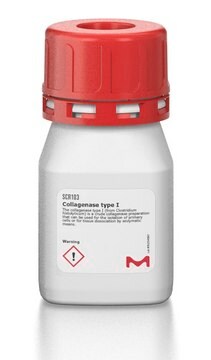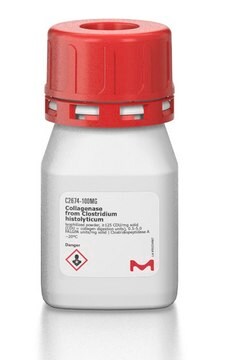1148090
USP
Colagenasa from Clostridium histolyticum
United States Pharmacopeia (USP) Reference Standard
Sinónimos:
Clostridiopeptidasa A
Iniciar sesiónpara Ver la Fijación de precios por contrato y de la organización
About This Item
Número de CAS:
MDL number:
UNSPSC Code:
41116107
NACRES:
NA.24
Productos recomendados
grade
pharmaceutical primary standard
manufacturer/tradename
USP
application(s)
pharmaceutical
format
neat
storage temp.
−70°C
¿Está buscando productos similares? Visita Guía de comparación de productos
General description
Collagenase II is a metalloprotease that acts as an endoprotease and exhibits a tripeptidyl carboxypeptidase activity. It shows endopeptidic activity with the main cleavage site found in front of the human collagen duplex amino acids glycine-proline. Hydrolysis takes place in the interior of the triple helical domains of collagen. Collagenase II is also known as class II collagenase and consists of three subtypes: δ, ε, and ζ. Collagenase II USP reference standard is provided as delivered and specified by the issuing Pharmacopoeia. All information provided in support of this product, including MSDS and any product information leaflets have been developed and issued under the Authority of the issuing Pharmacopoeia. For further information and support please go to the website of the issuing Pharmacopoeia.
Application
- Collagenase Type II for Enhanced Cell Isolation in Biomedical Research: Collagenase Type II is extensively applied in tissue dissociation for isolating cells, crucial for regenerative medicine and tissue engineering. It enables efficient breakdown of the extracellular matrix, facilitating easier cell extraction and purification for use in 3D cell culture and stem cell research. This enzymatic method is invaluable for studies requiring high-purity cell populations, making it indispensable in developing therapies for diseases like Parkinson′s and Alzheimer′s (Park et al., 2024).
- Advancing Tissue Engineering with Collagenase II: In tissue engineering, Collagenase II plays a pivotal role by degrading the collagen matrix in tissues, thereby enabling the cultivation of cells in a controlled environment. This process is essential for constructing tissue structures from the ground up, particularly in developing organoids that mimic natural organ functionalities. The use of high-grade biotech collagenase ensures reproducibility and effectiveness in these sophisticated applications (Wu et al., 2024).
- Collagenase II in 3D Cell Culture Systems: Collagenase II is instrumental in preparing extracellular matrices for 3D cell cultures, which are critical for studying cell behaviors in environments that closely replicate in vivo conditions. This enzyme helps in the accurate study of cellular interactions and pharmacological responses, providing a more realistic assessment of cellular dynamics in medical research (Jiang et al., 2024).
- Role of Collagenase II in Stem Cell Research: Utilizing Collagenase II in stem cell research enhances the isolation and maintenance of stem cells. This is particularly important for applications where the integrity and viability of stem cells are crucial, such as in regenerative medicine and therapeutic cloning. The enzyme′s ability to gently dissociate cells while preserving their functionality makes it a staple in cutting-edge biomedical research (Simón-Pérez et al., 2024).
- Collagenase II for Effective Extracellular Matrix Degradation: The ability of Collagenase II to efficiently degrade collagen-rich extracellular matrices is utilized in various biomedical applications, including cancer research where it aids in tumor microenvironment studies and drug penetration analyses. This enzymatic activity is crucial for understanding the interactions between cancer cells and their surrounding stroma, providing insights into potential therapeutic targets (Mohamed et al., 2024).
Biochem/physiol Actions
La colagenasa es activada por cuatro átomo-gramos de calcio por mol de enzima. Es inhibida por el ácido etilenglicol-bis(beta-aminoetil éter) - N, N, N′,N′-tetraacético, el beta-mercaptoetanol, el glutatión, el ácido tioglicólico y la 8-hidroxiquinolina.
Unit Definition
Una unidad de digestión de colágeno (CDU) libera péptidos del colágeno del tendón de Aquiles bovino que equivalen en la reacción de color de la ninhidrina a 1,0 μmoles de leucina en 5 horas a pH 7,4 y 37 °C en presencia de iones calcio. Una unidad de hidrólisis FALGPA hidroliza 1,0 μmoles de furilacriloil-Leu-Gly-Pro-Ala por minuto a 25°C. Una unidad de proteasa neutra hidroliza la caseína para producir color equivalente a 1,0 μmoles de tirosina por 5 horas a pH 7,5 y 37°C. Una unidad de clostripaína hidroliza 1,0 μmoles de BAEE por minuto a pH 7,6 y 25°C en presencia de DTT.
Analysis Note
These products are for test and assay use only. They are not meant for administration to humans or animals and cannot be used to diagnose, treat, or cure diseases of any kind.
Other Notes
This product is part of the USP Biologics program.
signalword
Danger
hcodes
pcodes
Hazard Classifications
Resp. Sens. 1
Storage Class
12 - Non Combustible Liquids
wgk_germany
WGK 1
flash_point_f
Not applicable
flash_point_c
Not applicable
Certificados de análisis (COA)
Busque Certificados de análisis (COA) introduciendo el número de lote del producto. Los números de lote se encuentran en la etiqueta del producto después de las palabras «Lot» o «Batch»
¿Ya tiene este producto?
Encuentre la documentación para los productos que ha comprado recientemente en la Biblioteca de documentos.
Los clientes también vieron
Yasin Emre Kaya et al.
Turkish neurosurgery, 30(3), 434-441 (2020-04-03)
To investigate the effects of metformin, a drug used widely for the treatment of type 2 diabetes mellitus, on human primary cell cultures prepared from uninjured segment of disc material intervertebral disk tissues. Primary cell cultures were prepared using the
Michalis Mastri et al.
American journal of clinical and experimental urology, 9(6), 416-434 (2022-01-08)
The evolving paradigm of the molecular classification of bladder cancer requires models that represent the classifications with less heterogeneity. Robust transcriptome based molecular classifications are essential to address tumor heterogeneity. Patient derived models (PDMs) are a powerful preclinical tool to
Nuestro equipo de científicos tiene experiencia en todas las áreas de investigación: Ciencias de la vida, Ciencia de los materiales, Síntesis química, Cromatografía, Analítica y muchas otras.
Póngase en contacto con el Servicio técnico







